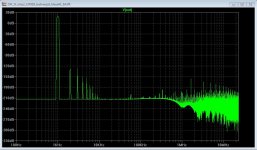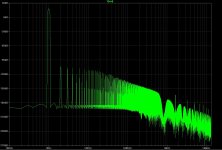Hi all,
In a different thread, Nico Ras talked about distortion profiles in relation to power supplies, notably, how powersupplies could be made 'clean' enough so that the profile left would be that of the amp. Well, this set off some inspiration to take a closer look at the harmonic distortion profiles and how we would go about them.
John Curl wrote this nice page about the distortion profiles of JFETs and basic input stages. I sort of took his work and continued where he left of when it comes to simulation. NOTE: I didn't bother with ideal components (LAMBDA=0) as they don't exist for real
There are basically 3 situations:
Single device: Even harmonic (2nd)
Dual device, differential: Odd harmic (3rd)
Quad device, push/pull differential: Odd harmonics(3rd) along with much weaker even harmonics, same degrading pattern
Then there is a fourth situation that I learnt in the simulator:
All harmonics from 2nd and up being pretty much equal! Oddball? Sort of.. This situation seems to suggest that the harmonics production is below the overall noise floor.
Since we're dealing with non-ideal devices, though are able to match closely we're able to reduce distortion by a good margin, though it's a bold idea to think we can get rid of the harmonics distortion.
Now it is known that the 2nd harmonics are a bit 'nicer' to the ear than the odd harmonics if you have to deal with listening to distortion, but if possible I suppose we don't want to hear them at all.
So I guess this leaves the final question: What is more important to you? Prominently even harmonics over odds..? Even when in another the odds would be more prevalent, though overall levels lower than the 2nd harmonic of the first situation?
Would you be satisfied if the amp manages to stomp harmonics distortion into the noise floor?
In a different thread, Nico Ras talked about distortion profiles in relation to power supplies, notably, how powersupplies could be made 'clean' enough so that the profile left would be that of the amp. Well, this set off some inspiration to take a closer look at the harmonic distortion profiles and how we would go about them.
John Curl wrote this nice page about the distortion profiles of JFETs and basic input stages. I sort of took his work and continued where he left of when it comes to simulation. NOTE: I didn't bother with ideal components (LAMBDA=0) as they don't exist for real
There are basically 3 situations:
Single device: Even harmonic (2nd)
Dual device, differential: Odd harmic (3rd)
Quad device, push/pull differential: Odd harmonics(3rd) along with much weaker even harmonics, same degrading pattern
Then there is a fourth situation that I learnt in the simulator:
All harmonics from 2nd and up being pretty much equal! Oddball? Sort of.. This situation seems to suggest that the harmonics production is below the overall noise floor.
Since we're dealing with non-ideal devices, though are able to match closely we're able to reduce distortion by a good margin, though it's a bold idea to think we can get rid of the harmonics distortion.
Now it is known that the 2nd harmonics are a bit 'nicer' to the ear than the odd harmonics if you have to deal with listening to distortion, but if possible I suppose we don't want to hear them at all.
So I guess this leaves the final question: What is more important to you? Prominently even harmonics over odds..? Even when in another the odds would be more prevalent, though overall levels lower than the 2nd harmonic of the first situation?
Would you be satisfied if the amp manages to stomp harmonics distortion into the noise floor?
Harmonics behaviour
Hello,
Can somebody help me to deal with harmonics distortion. It is ok when device works in class A, about 2 A through MOSFETS. But when switched to class B higher harmonics rises. I saw that is not case on some high quality BJT amps. Can it be cose of MOSFET output or spice models?


Hello,
Can somebody help me to deal with harmonics distortion. It is ok when device works in class A, about 2 A through MOSFETS. But when switched to class B higher harmonics rises. I saw that is not case on some high quality BJT amps. Can it be cose of MOSFET output or spice models?


I look for deadbands when I see a flat level spray of harmonics - check bias levels - could be dynamic bias probelm too
assuming good "measurement" conditions - smooth window, exact fit of integer number of signal periods to fft length, fine enough t_max_stepsize
assuming good "measurement" conditions - smooth window, exact fit of integer number of signal periods to fft length, fine enough t_max_stepsize
Last edited:
I look for deadbands when I see a flat level spray of harmonics - check bias levels - could be dynamic bias probelm too
assuming good "measurement" conditions - smooth window, exact fit of integer number of signal periods to fft length, fine enough t_max_stepsize
In this design bias changes dynamically, does it ultimately result in bad sound?
- Status
- This old topic is closed. If you want to reopen this topic, contact a moderator using the "Report Post" button.